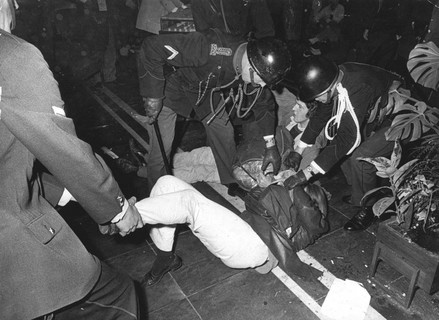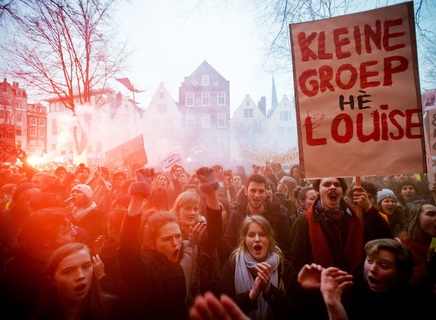Strijd ∞ gives a visual overview of the Maagdenhuis’ history of protests.
Ten years after the last occupation of the Maagdenhuis, the battle for more democracy at universities is an ongoing process. The same activist spirit that sparked the famous 1969 occupation of the Maagdenhuis, led to the 11th re-appropriation of this now prominent building in 2015, and to similar movements elsewhere (e.g London's LSE). This historical sequence started when students demanded a greater voice in what they were being taught, and a less authoritarian way of governing towards university policy. These protests express a collective spirit for the values of education and the necessity of students (and staff) to have a say in how that is delivered.
1969:
During the five days that the occupation lasted the police barricaded all the entrances in the hopes that hunger and thirst would make the occupiers decide to leave. What the police didn’t anticipate was that the students would outsmart the police by building a provisional bridge between the Maagdenhuis and the University Aula next to it (also a church), thereby being able to bring food into the building. After five days the students were violently evicted from the building by police, but the message was clear.
1978, 1980, 1986:
In 1978 the Maagdenhuis was occupied twice, out of protest against changes in the law concerning the governance of universities. The occupation of 1980 had a feminist touch to it: two female applicants were not appointed to professorships. 1986 saw students express their dissatisfaction with the reforms of the study grant.
1990, 1993, 1996:
Protests succeeded each other in 1990, 1993 and 1996.
2005:
The year 2005 saw the 10th occupation of the Maagdenhuis. Students disagreed with the plans of the Prime Minister to raise the tuition fees for those studying more than five and a half years, and also to limit the voice of the students in how institutions of higher education were being governed. Yet another violent eviction followed.
2015:
In protest to the reforms set forth by the President and Board of the University of Amsterdam, students and professors alike created a new movement called De Nieuwe Universiteit (The New University) in order to change the educational system and preserve the studies in the Faculty of Humanities. Protestors briefly occupied the Bungehuis building, then repurposed/occupied the Maagdenhuis for over a month and a half, resulting in the resignation of the University's President and Board, one among many of the movement's requests. This is only the beginning of an infinite struggle to democracy in the university system at large.
What this overview shows is how not only the objectives of the occupations have changed little over time, but also how students and staff have expressed their protests and values through similar gestures.
1969:
During the five days that the occupation lasted the police barricaded all the entrances in the hopes that hunger and thirst would make the occupiers decide to leave. What the police didn’t anticipate was that the students would outsmart the police by building a provisional bridge between the Maagdenhuis and the University Aula next to it (also a church), thereby being able to bring food into the building. After five days the students were violently evicted from the building by police, but the message was clear.
1978, 1980, 1986:
In 1978 the Maagdenhuis was occupied twice, out of protest against changes in the law concerning the governance of universities. The occupation of 1980 had a feminist touch to it: two female applicants were not appointed to professorships. 1986 saw students express their dissatisfaction with the reforms of the study grant.
1990, 1993, 1996:
Protests succeeded each other in 1990, 1993 and 1996.
2005:
The year 2005 saw the 10th occupation of the Maagdenhuis. Students disagreed with the plans of the Prime Minister to raise the tuition fees for those studying more than five and a half years, and also to limit the voice of the students in how institutions of higher education were being governed. Yet another violent eviction followed.
2015:
In protest to the reforms set forth by the President and Board of the University of Amsterdam, students and professors alike created a new movement called De Nieuwe Universiteit (The New University) in order to change the educational system and preserve the studies in the Faculty of Humanities. Protestors briefly occupied the Bungehuis building, then repurposed/occupied the Maagdenhuis for over a month and a half, resulting in the resignation of the University's President and Board, one among many of the movement's requests. This is only the beginning of an infinite struggle to democracy in the university system at large.
What this overview shows is how not only the objectives of the occupations have changed little over time, but also how students and staff have expressed their protests and values through similar gestures.


